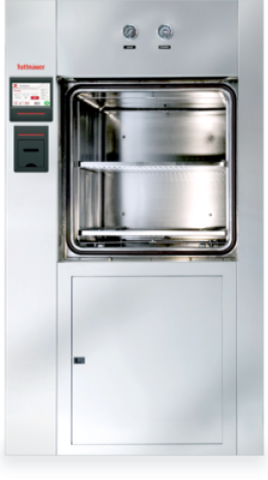Autoclaving Media Mishap Leads to Student Injury
June 2024
What Happened?
 Autoclaving media can be tricky. It is easy to overload the autoclave when processing
large loads. For accuracy in sterilizing media, it is good practice to use a temperature
probe in a “dummy” media bottle to make sure the unit receives adequate feedback for
the run. Dummy bottles should be the same size and contain the same volume of water
as the largest media container in the load; these containers should be placed centrally
within the loaded materials.
Autoclaving media can be tricky. It is easy to overload the autoclave when processing
large loads. For accuracy in sterilizing media, it is good practice to use a temperature
probe in a “dummy” media bottle to make sure the unit receives adequate feedback for
the run. Dummy bottles should be the same size and contain the same volume of water
as the largest media container in the load; these containers should be placed centrally
within the loaded materials.
In this incident, an experienced student worker was removing a load of media from the autoclave. The student was at the point in the process where the dummy bottle was being removed from the load and set aside on the ground for the next run. When the student placed the container on the ground, the bottom ruptured spilling the autoclaved water onto the ground and splashing on to the top of the student's foot. The water was still very hot, and the contact resulted in minor first and second degree burns to the student's big toe.
What Caused the Accident?
- Multiple factors could have contributed to the media bottle rupturing.
- The media bottle used was larger than the media bottles in the load with an equivalent amount of water. The underfilled container likely become overheated during the run making it more fragile than usual.
- The student felt they may have set the bottle down too firmly on the hard concrete in the autoclave room – rupturing the container.
- These bottles are generally left in the room for convenience. It is unlikely that the bottle was properly evaluated prior to reuse. Small fractures in the vessel could have gone unnoticed and contributed to the vessel rupturing with the sudden temperature difference from the autoclave to the floor.
- Proper lab attire was not worn. While PPE was worn while removing the load from the autoclave, the student was not wearing proper footwear. At the time of the incident, the student was wearing breathable sneakers which allowed the hot water to contact her foot. EHS requires that solid shoes (i.e., water resistant) that cover the top of the foot be worn in laboratories to prevent such incidents.
How Can We Prevent Future Accidents and Minimize Injuries?
Actions taken to address this incident included the following:
- Underfilled bottles will not be used. A correctly sized dummy bottle will be used to prevent superheating of the glass and optimize media sterilization.
- Glassware will be inspected before use to identify chips, cracks, and stars that can lead to vessel compromise.
- Secondary containment will be used for the dummy bottle when it is left in the autoclave room for additional use. Instead of just placing the bottle on the ground, the bottle will be placed in secondary containment with an absorbent pad to help cushion the bottle and absorb spills.
- Proper lab footwear will be reinforced in the laboratory. This event could have been prevented if proper footwear had been worn in the laboratory.
Final Thoughts
Another intervention that is a possibility is replacing the dummy bottle with a plastic one. While this would prevent a broken glass situation, plastic transfers heat much more slowly than glass which could result in damaged media from overheating.
Glassware breaking in the laboratory is not an unusual occurrence, but it typically is an unexpected one. Inspecting glassware prior to use is the first step in preventing spills from a compromised vessel, but as we all know, spills happen so be proactive in protecting yourself and others. As we saw in this incident, wearing your PPE and appropriate lab attire can be the difference between a near miss and an incident.
Environmental Health & Safety
-
Address
Texas Tech University, 407 Flint Ave, Lubbock, TX 79409 (Mail Stop 1090) -
Phone
806.742.3876 -
Email
safety@ttu.edu
